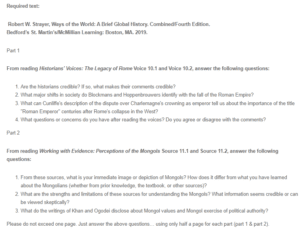Reflecting on Historical Perspectives and Insights
Part 1
Question 1
Historians’ voices can be credible based on the circumstances surrounding the historical facts and the authors of the piece of history. One of the pointers of historical credibility is if the author was present at the time of the occurrence of an event, thus first-hand reporting.
Question 2
Blockmans and Hoppenbrouwers have made a huge contribution toward making European history not only interesting but also relevant. One of the shifts characterized by Blockmans and Hoppenbrouwers is the desire to appeal with intuition, emotion, imagination, and passion over reason and scientific reasoning.
Question 3
Cunliffe’s description of the dispute over Charlemagne’s crowning shows that the Roman Empire did not align with the religious prescription of the papacy to make Charlemagne the emperor of the Roman Empire. The coronation of Charlemagne gave the church implicit authority over the Roman emperor, and this did not go well with the secular empire.
Question 4
The conflict that emerged in the Roman Empire cements the historical reality that religion and authority cannot blend. I agree with the voices since they are relevant even in the contemporary world.
Part 2
Question 1
What is surprising about the Mongolian people is the power that is bestowed on women. From the outset, the Mongolians appear to be quite conservative people, but it turns out that their women occupied high political offices, including offering counsel to the military.
Question 2
The assertion about the Mongols is credible due to the nature of the evidence provided. For instance, ancient Greek writers recorded first-hand accounts of the lives of the women and men of Mongol, such as how women even rode horses.
Question 4
The writings of Khan and Ogodei disclose that the Mongols were strict adherents to their culture and governance structures. Also, political authority among the Mongols was organized along clan relations.
References
Strayer, R. W., & Nelson, E. (2009). Ways of the world: A brief global history. Bedford/St. Martin’s.
ORDER A PLAGIARISM-FREE PAPER HERE
We’ll write everything from scratch
Question

Reflecting on Historical Perspectives and Insights
Required text:
Robert W. Strayer, Ways of the World: A Brief Global History. Combined/Fourth Edition.
Bedford’s St. Martin’s/McMillian Learning: Boston, MA. 2019.
Part 1
From reading Historians’ Voices: The Legacy of Rome Voice 10.1 and Voice 10.2, answer the following questions:
- Are the historians credible? If so, what makes their comments credible?
- What major shifts in society do Blockmans and Hoppenbrouwers identify with the fall of the Roman Empire?
- What can Cunliffe’s description of the dispute over Charlemagne’s crowning as emperor tell us about the importance of the title “Roman Emperor” centuries after Rome’s collapse in the West?
- What questions or concerns do you have after reading the voices? Do you agree or disagree with the comments?
Part 2
From reading Working with Evidence: Perceptions of the Mongols Source 11.1 and Source 11.2, answer the following questions:
- From these sources, what is your immediate image or depiction of Mongols? How does it differ from what you have learned about the Mongolians (whether from prior knowledge, the textbook, or other sources)?
- What are the strengths and limitations of these sources for understanding the Mongols? What information seems credible or can be viewed skeptically?
- What do the writings of Khan and Ogodei disclose about Mongol values and Mongol exercise of political authority?
Please do not exceed one page. Just answer the above questions… using only half a page for each part (part 1 & part 2).

